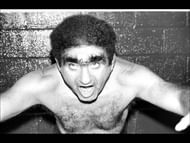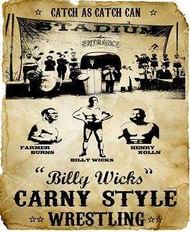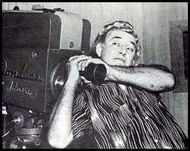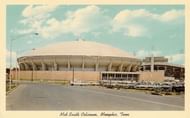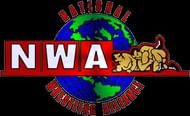In the early 1900's, pro wrestling was viewed as a legitimate sport and the event results were reported anywhere they had sports scores and results. Throughout the eventual evolution of the industry, the gimmicks and characters became much more outlandish and not too long after, fans started putting two and two together and came to the conclusion that there's a degree of theatrics behind what they thought to be nothing more than just another sport.
In this article, we look at five era's that defined the industry, before professional wrestling was popular.
5. BIRTH OF THE HARDCORE ERA
WWE has no plans for these former AEW wrestlers? Here's why!
There is a huge misconception that hardcore wrestling was born, or established in the late 80's or the 90's. Contrary to popular belief, the hardcore style of wrestling was around long before ECW brought it to the forefront. In fact, the roots of hardcore wrestling can be traced all the way back to the 1930's.
His name was Bull "Wildman" Curry and he was indeed a wildman. Bull began wrestling in the 1920's. His first introduction to wrestling was when he joined a traveling circus. During the shows, he would accept challenges from anyone in the crowd who dared to challenge the “Wildman”. At one point, he had an undefeated streak of nearly 70 bouts without anyone going beyond a single five-minute round with the resident tough guy.
As the industry evolved, so to did the career of Curry. He had the unique ability to get an entire crowd to turn against him, to the point where he was known as "the walking riot." Anytime he would win a match, the crowds would start an all-out riot amongst the spectators.
Curry is attributed to being the first wrestler to use weapons such as steel chairs, garbage cans and anything else he could get his hands on. Legendary hardcore wrestlers such as The Original Sheik and Abdullah the Butcher have credited Bull Curry as the true innovator of hardcore wrestling.
4. THE CARNY ERA
The Carny Era (Carnival Era) was a unique time in the history of professional wrestling. Beginning in the late 1800's, carnival workers would work as bookers and promoters who would go out and find big, brutish men to come and join their travelling shows from town to town, holding impromptu matches against one another. There have been instances where the wrestlers would compete against a live bear, just to spark interest and sell tickets to the shows, which would also result in more patrons at their carnivals.
Along with these traveling carnivals, there would also be large, traveling circuses who would also book these wrestlers from time to time as well. During this time, a lot of the over-the-top characters and gimmicks would come to life. The Carnival Era was very influential to the overall evolution of the business as we now know it.
3. TV REVOLUTION ERA
In the early 1950's, more and more households were getting television sets in their homes and it revolutionized all aspects of the entertainment industry, including pro wrestling. This was an exciting time for fans because up until this point, most fans got their product wrestling "fix" via newspapers and radio reports. When televisions became more common, companies like Dumont would start picking up wrestling television shows and airing them all across the United States.
With the advent of television, characters such as Gorgeous George became increasingly charismatic and would begin to overly accessorize their ring and entrance gear, creating a much more captivating product, resulting in an ever-increasing audience. Not only would the pure wrestling fans jump on board, but also the fans of theater and arts began gravitating to this new concept of wrestling, as a form of entertainment.
2. MEMPHIS 'RASSLIN BOOM
Memphis, Tennessee is one of America's more centrally located major regions. It was only a matter of time before promoters started looking at the mid-south as what would become one of the premier hotbeds for professional wrestling. One of the prominent names in Memphis wrestling history, was Sputnik Monroe. Sputnik was credited for breaking down the deep south segregation problems within wrestling venues. At a time when whites sat in the floor seats, while blacks sat in the balcony, Monroe went public, voicing his dislike for the practice. In fact, Sputnik would dress in his most dapper, flamboyant clothing and go into urban areas of Memphis and encourage the African American fans to come out to the shows, which eventually led to a multicultural boom in the area.
The Memphis region would continue to thrive, throughout and beyond the birth and explosion of the territory days. The Mid-South Coliseum would be the site of the birth of many legendary careers. Names such as Jerry Lawler, Junkyard Dog and Tommy Rich would find unprecedented success at the fairgrounds venue.
1. THE RISE OF THE NWA
The National Wrestling Alliance was born in 1948, long before any sort of "Territory Era" had ever been thought of. The idea was to create a sole governing body for a number of wrestling promotions throughout the country, resulting in the first truly recognized world champion.
Over time, talent from all over the world would flock to the National Wrestling Alliance in hopes of landing a shot at what is now known more commonly as the "ten pounds of gold." In the early days of NWA's rise, there were many smaller promotions who advertised championship bouts at their respective events. However, they quickly learned that they could achieve much more success, at a higher level if they would affiliate themselves with the NWA.
Lou Thesz, Ric Flair, Buddy Rogers and Verne Gagne are just a few of NWA's groundbreaking stars. It was because of these premier names holding the NWA World Heavyweight Championship that success would be sustained for years to come. The National Wrestling Alliance is still in existence today and has seen a recent surge in popularity.
How WWE has messed up John Cena's last run - Check here!
